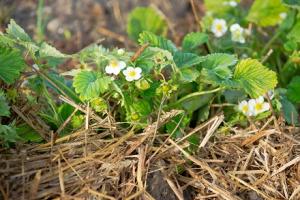Richard Jauron
Extension Horticulturist
515-294-3108
rjauron@iastate.edu
Weeds compete with small fruit plants for the elements needed to grow and produce fruit, which means gardeners need to be diligent about weed control. Horticulturists with Iowa State University Extension and Outreach provide weed control options for gardeners with strawberries, raspberries and vineyards. To have additional questions answered, contact Hortline at 515-294-3108 or at hortline@iastate.edu.
How do I control weeds in my strawberry patch?
 Weed control is essential to ensure optimal plant growth and fruit production. Weeds compete with the strawberry plants for water, nutrients and sunlight. Weeds also reduce air circulation, which results in the fruit and foliage staying wet for longer periods. The severity of disease problems increases the longer the plant tissue remains wet.
Weed control is essential to ensure optimal plant growth and fruit production. Weeds compete with the strawberry plants for water, nutrients and sunlight. Weeds also reduce air circulation, which results in the fruit and foliage staying wet for longer periods. The severity of disease problems increases the longer the plant tissue remains wet.
Cultivation, hand pulling and mulching are the most practical weed control measures for home gardeners. Cultivate often, but shallow, to control weeds. Destroy weeds before they have a chance to flower and produce seeds. Clean, weed-free straw and other organic materials can be applied as a mulch between plant rows. Herbicides are not a viable option, as few herbicides are labeled for use in home strawberry plantings.
How do I control weeds in my raspberries?
Cultivation and mulches are the most practical weed control measures for home gardeners. Frequently cultivate the raspberry planting in spring and summer. To prevent injury to the roots of the raspberry plants, don’t cultivate deeper than 2 to 3 inches.
Mulches help to control weeds and conserve soil moisture. Possible mulching materials include straw, shredded leaves, lawn clippings, sawdust and wood chips. The depth of the mulch needed depends upon the material. The depth ranges from 3 to 4 inches for fine materials, such as sawdust, to 8 to 10 inches for straw. Apply the full depth of the material between rows. Apply lighter amounts within the plant row. Avoid mulching poorly drained soils to discourage root diseases. Since mulches gradually decompose, apply additional material each year.
How do I control weeds in the home vineyard?
Keep the area under the grape trellis weed-free. Hand hoeing is the most practical weed control method for home gardeners. Cultivation should be shallow to prevent damage to the grapevine roots. Mulches also help control weeds. Shredded leaves, grass clippings, straw and wood chips work well. In most situations, 2 to 3 inches of mulch are adequate.
Maintain a cover crop between rows. Permanent cover crops help control weeds and prevent soil erosion. Kentucky bluegrass is an excellent cover crop. It grows well in Iowa and competes with grapes less vigorously than other cover crops. Maintain the bluegrass at a height of 2.5 to 3.5 inches. Leave the grass clippings on the area when mowing.
